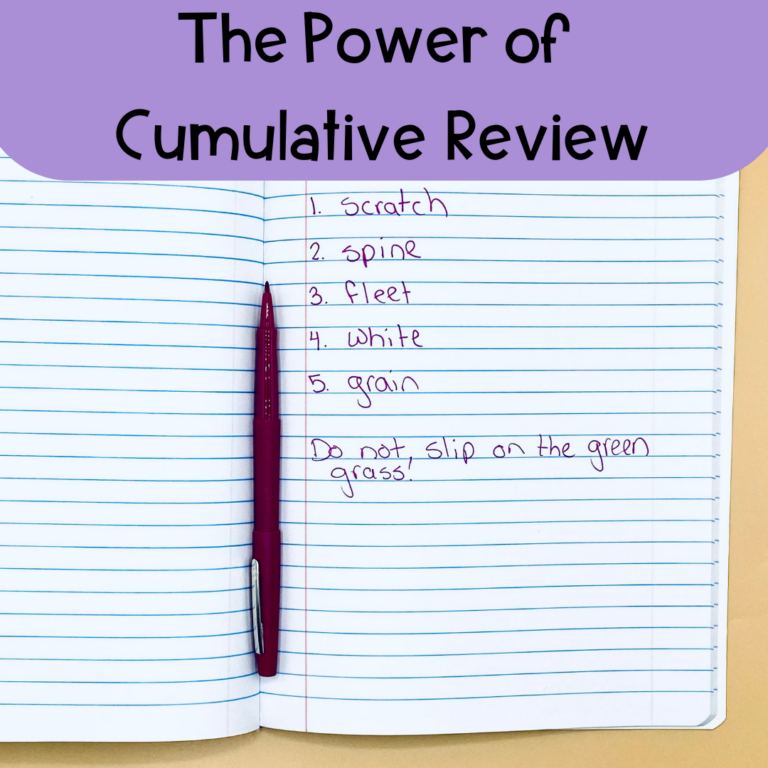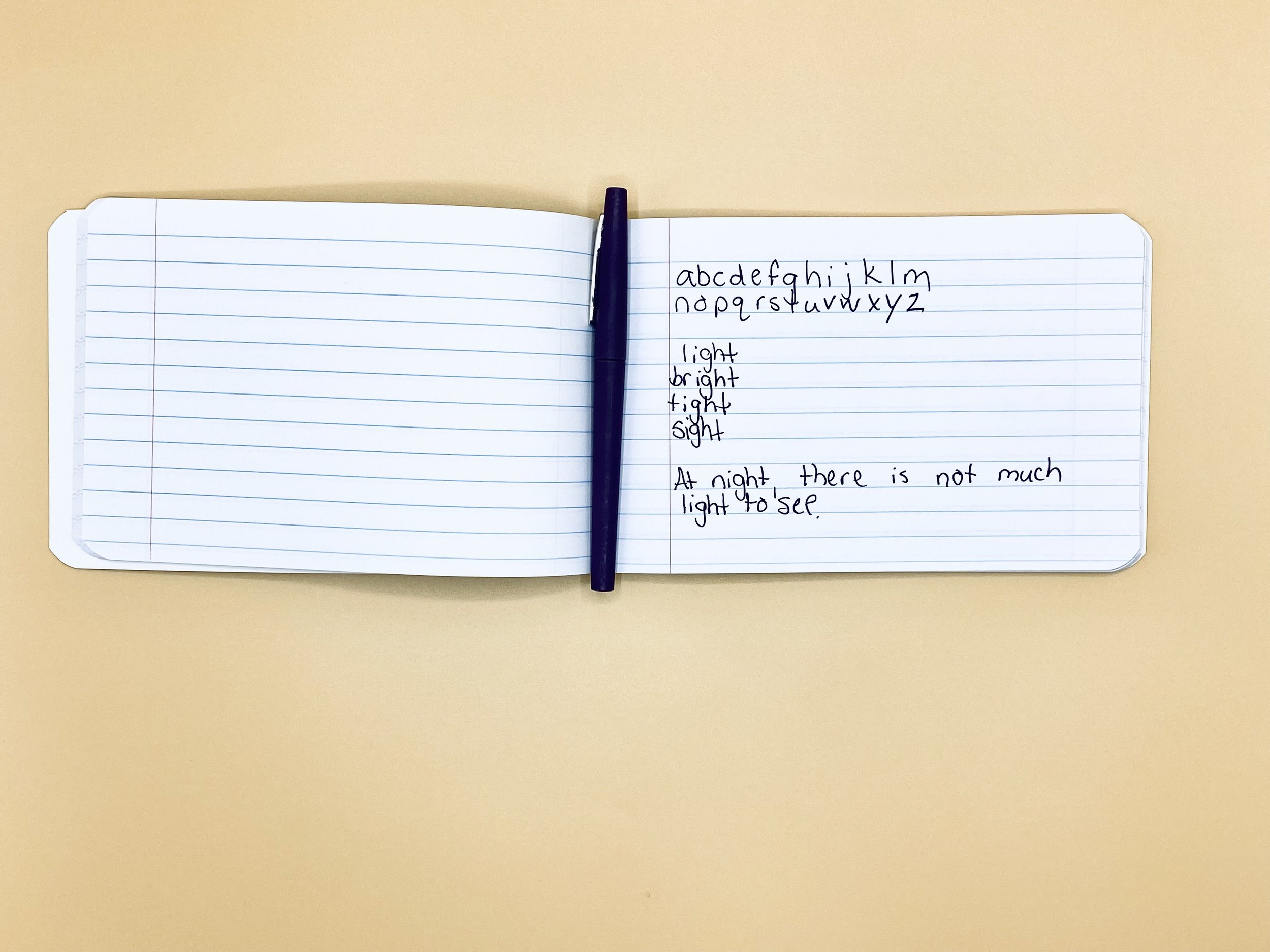
Share This:
I am the queen of simplicity and anti-hoarding. If I haven’t used it in the past year or two, it’s going in the trash or the recycling bin. I don’t get attached to objects in my classroom just because money has been spent on them, especially if they are not aligned with best practices. I don’t keep stinky books, outdated games, or materials that I “might” use one day (Look, we all know we’re never using it). I find so much peace in keeping thing simple.
All that being said, what ARE my must-haves for children? Today, I am going to share the 5 essentials I have for my students. If I am teaching phonics, these have to be present. There are tons of other materials that are nice to have, but none are quite as important as the items listed below.

Really, Savannah? A notebook? How many times are you going to tell me I need a notebook? Yes, a notebook is #1. In a world where digital reigns supreme, we have to remember how important it is for our children to do real writing on real paper. Every day my children use a notebook to write their ABCS and for dictation. Whiteboards are nice, tablets are nice, but we must always remember how important it is for children to write with actual paper.
Loose paper annoys me, so I always use a composition book (I get the half-sized ones at Wal-Mart during back-to-school time). For k-2, I like to use one with a midline. A midline is the dotted line you find on some notebooks. They are more expensive than the wide-ruled notebooks, but they are essential. If I had just a little bit of money each year for my classroom, I would use it to buy notebooks with a midline. Oriental Trading has sets of 12 for $20.
Once students hit 3rd grade, I tend to use regular notebooks!

Decodable folders are so important, they recently got their own post. They are important because for early readers, decodable texts are the access to the code. Instead of a steady diet of leveled readers that aren’t controlled for any phonics patterns, a decodable folder gives students access to texts that have skills they have been taught.
Why a folder and not physical books? Well, you can definitely do both! But it is a lot more expensive to buy physical books, so a decodable folder is a great place to start. Once your school’s library of decodable texts increases, feel free to give students the books to read. But unlike a book, I don’t need the decodable folders back. They can stay in my student’s desks the entire year. It is essential that children have time to read texts they can actually read—decodable folders give them immediate access to that. I can
Right up there with decodable folders is a review deck. A review deck is a deck of cards with words or sentences on them. You organize the deck each week so that you add new words based on skills you’ve taught and take out some words that have become automatic.
Why is a review deck so important? I find cumulative review to be the missing piece in many classrooms. You’ll see incredible, explicit instruction for the phonics skills that have been taught. But then the next week comes and previous skills are expected to be internalized. We want to practice the skills we have taught so much that they can immediately, automatically recall the words (orthographic mapping, anyone?).
The drawback to a review deck is that they can expensive and time consuming. If you have multiple groups, creating different decks each week for your groups can take a lot of time. Over the past year, I spent months creating a digital version that takes a lot less time to put together each week (and is a lot less expensive than those pre-printed ones). Check out the video above to see how you can create a review deck in 5 minutes each week!

This is a very Orton-Gillingham thing, but luckily you don’t need any extensive training to use a salmon and white deck. A salmon and white deck is a deck of cards with graphemes on them. Each day, you start your lesson by flashing the graphemes you have taught, and having students tell you the sound or sounds that those graphemes make.
Think of it like a deck of ABC cards. For your youngest students, this is exactly how it will start! You will flash the letters of the alphabet, one at a time and out of order. Children will tell you the sound(s) that grapheme make. As you teach additional skills, like digraphs, vowel teams, etc., you will add those cards to your deck.
In general, I will take out any consonants once they have become automatic. I do not ever take out the vowels, because those tend to be the most problematic for students.

I love phonics notebooks. They were my first real big project, and I’ve loved them ever since they came out in 2020. A phonics notebook is a half-page notepage that goes into a composition book or spiral notebook. Each page provides short practice aligned to a skill.
These notebooks are not intended to be used as independent work. There are several pages where the teacher must do some dictation work for the students. Instead, they are a time to get initial practice in a phonics skill.
At the end of the year, I keep my students’ phonics notebooks. If I have them in intervention again, we will use the same notebook to keep growing our understanding. If working in a school that utilizes phonics notebooks school-wide, you could have the notebooks go to the next year’s teacher.
There’s many other materials I use in my small groups—fluency grids, games, manipulatives, etc. They all add value to my teaching—but you don’t have to have all these materials to be a good teacher, and I wanted you to know what I truly found essential. When I think about my lessons over a week, I simply couldn’t function without those five materials.
So what are your essential materials? I always try to think about it in this way—is my instruction, and the materials I’m using to support that instruction, giving children the reading and spelling practice they need to become proficient? In a world full of stuff, sometimes it is nice to take it back to the simplest practices.
Share This:

Savannah Campbell is a K-5 reading specialist. She has taught her entire 12-year teaching career at the school she went to as a child. She holds two master’s degrees in education from the College of William and Mary. Savannah is both Orton-Gillingham and LETRS trained. Her greatest hope in life is to allow all children to live the life they want by helping them to become literate individuals.

Savannah Campbell is a K-5 reading specialist. She has taught her entire 12-year teaching career at the school she went to as a child. She holds two master’s degrees in education from the College of William and Mary. Savannah is both Orton-Gillingham and LETRS trained. Her greatest hope in life is to allow all children to live the life they want by helping them to become literate individuals.
Feeling overwhelmed with all the terminology out there? Want to know the key terms all teachers need to teach phonics? In this FREE Rules of English cheat sheet, you get a 5 page pdf that takes you through the most important terms for understanding English—you’ll learn about digraphs, blends, syllable types, syllable divisions, and move. Grab today and take the stress out of your phonics prep!
